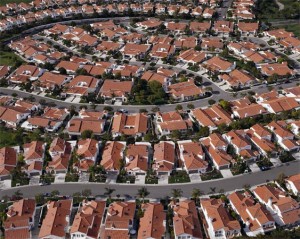That question is at the heart of SB 375 (Steinberg), California’s supposedly landmark land use and climate change law passed in 2008. It was a complicated law, but in short it required regional transportation plans to direct more transportation dollars to infill areas, in order to meet state greenhouse gas targets. It included some regulatory streamlining as well for development projects consistent with that plan.
It was a worthwhile idea. After all, approaching land use issues in metropolitan areas at a regional scale makes a lot of sense. We should be spending dollars where the most people can live and work, and not encouraging sprawl by investing in outlying transportation infrastructure.
But the problem is that land use and transportation decisions are mostly made at the local level. On land use, cities and counties have virtually complete control over what gets built in their jurisdictions. They control the zoning and grant virtually whatever exceptions they want to that zoning. The state and regional entities have practically no authority over those decisions.
Transportation is more complicated, with the state raising and spending about one-quarter of the transportation dollars. But locals raise half the dollars statewide, and even when regional entities have decision-making authority over transportation funds, local elected officials are the ones who sit on those governing boards. The result is either weak regional plans or strong plans that are unlikely to be implemented.
SB 375 did nothing to change this dynamic and actually give decision-making authority to the regional entities producing these plans — or at least require local compliance. Not to mention that SB 375 gives regional entities much wiggle room to avoid making meaningful changes to comply with the state targets.
That’s why I’ve been gloomy about SB 375 from the beginning, wondering if it’s even worth it for smart growth advocates to invest much time in helping to implement the law.
Now we finally have an academic study to support this contention. Researchers at the University of Illinois at Urbana-Champaign studied the effects on land use of Sacramento’s 2004 “blueprint” plan, which inspired SB 375. The results don’t look good, as the authors summarize (subscription required):
Unfortunately, we find that highly rated neighborhoods—those whose attributes were matched to Blueprint’s overall priorities—received relatively fewer residential units than did neighborhoods less aligned with the regional plan. Furthermore, on average, more residential development in the post-plan period occurred in less highly rated neighborhoods than before the implementation of the plan. We also find major differences in acceptance of the regional -planning principles in some jurisdictions than others; for example, Sacramento, with more opportunities for infill development, was more likely to adopt some of the regional plan principles, while smaller suburban communities with large tracts of developable land were more likely to build traditional suburban housing.
Mike McKeever, executive director of Sacramento’s regional entity, was understandably defensive about the study, as quoted in the Sacramento Bee:
[McKeever] countered that the report appears to have an anti-suburb bias. Greenfield or open space development can be consistent with Blueprint principles if designed correctly, he said. He also said it is too early to get a solid view of the effectiveness of the plan, which seeks to influence development patterns over a 45-year period.
“We never were delusional to think that everything was going to change on a dime,” McKeever said. Growth in the last decade has been unusual, he said, with a huge spurt of the early 2000s when pre-Blueprint projects were in the pipeline, followed by a complete collapse of home building in 2007.
Sure, it was a strange decade for real estate. And yes there were bad projects in the pipeline in 2004. But there are still bad projects in the pipeline today, such as Cordova Hills, a sprawl project referenced in the Bee article that the county approved despite its conflict with the Blueprint.
The real issue for smart growth advocates, as the study authors recognize, is how to influence local decision-making to implement these regional plans. Otherwise they will have minimal real-world value other than as nice planning exercises that may help already-sympathetic jurisdictions build a bit more infill.
It’s a tough political challenge given the power of the local government lobby, and it may require going city-by-city to organize residents and encourage good planning and implementation. It will also require work-arounds, such as through changes to the state’s environmental review law, the California Environmental Quality Act (CEQA), to evaluate traffic impacts of new real estate projects based on vehicle miles traveled rather than auto delay, as SB 743 requires. Advocates can also encourage better standards for evaluating new transportation projects to ensure they meet greenhouse gas and vehicle miles traveled goals.
Short of legislative amendments to SB 375, it will take this kind of creative problem-solving to make a difference. Because SB 375 alone won’t get it done.
Leave a Reply
You must be logged in to post a comment.



